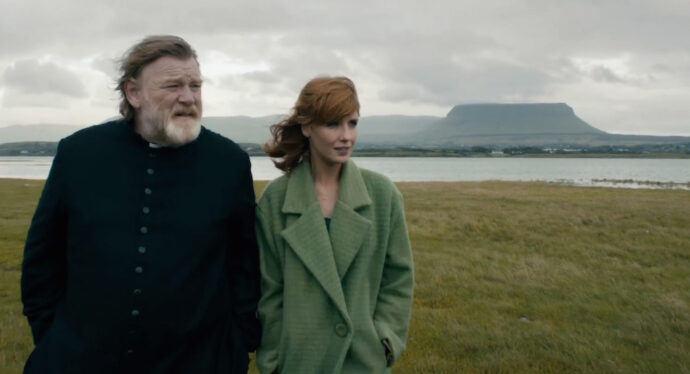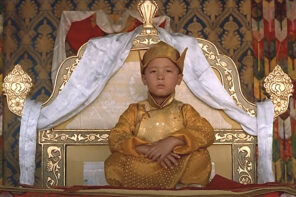Brendan Gleeson is a mountain. Tall, broad, swathed in a black soutane buttoned from neck to knees, he lurches through Sligo’s wild green countryside, red-haired and white-bearded, a real old-fashioned picture of a priest. The tricky thing is that this is 2014, and the Irish Catholic church has lost much of its moral authority due to the priestly abuse scandals, the aftereffects of which set the events of Michael McDonagh’s film Calvary into motion.
Gleeson’s Father James embodies many of the contradictions of what it means to be a priest today. A recovering alcoholic, the father of a depressed adult daughter, and a widower who found his vocation in midlife, he’s stuck at a tiny parish with a bean-counting younger priest and a dog as his only steady companions. Father James is both deeply empathetic, and, like many priests, a bit of a puzzle to figure out. Gleeson’s face mirrors the creased and blasted surface of Benbulbin Mountain, which looms over the film like a portent. But many other things loom over Calvary like portents: its supporting characters, its plot, its swollen soundtrack, and its compelling but oddly incomplete attempt to explicate what forgiveness means in an age when organized religion may be dying, but little has stepped up to take its pace.
The plot is set into motion in the most old-fashioned of Catholic symbols, the confessional. A male voice tells Father James that he was raped by a priest as a child, and, as an act of revenge, he will kill Father James at an appointed time. Why not kill the abuser? He’s already dead, and besides, the killer tells the priest, killing a bad priest is nothing. But killing a good one, well, that’s a film.
Had nearly every supporting character in Calvary worn a sandwich board reading “BAD GUY” or “BAD GIRL” the film’s depiction of evil would have been more subtle than it actually is.
And Father James, as Calvary points out, is indeed a good priest. A man of prayer and a man of action, he listens to people, counsels them, and sits with them through moments of pain, loss and confusion. There is no moral middle ground in Calvary: there is only sin, sinners, and sinfulness, with the slightest glimpse of something like redemption.
Juxtaposed against that kind of fallen world, any priest who doesn’t abuse children or drink away the parish funds would probably be wearing a halo, but Gleeson makes it clear that Father James’ goodness is earned through suffering. The world around him is ugly and corrupt, and pain flickers across his face in moments of encounter with that ugliness. But it’s merely a registration of the fact that suffering is inescapable. Father James moves on, full speed ahead, to compassion.
Nonetheless, the film depicts the kind of place where the town tart wears a leopard print coat and red lipstick; the town doctor is a cokehead whose paths drip oily facetiousness (and is played by Game of Thrones’ Aiden Gillen, aka Littlefinger, with his Littlefinger moustache and soul patch intact); the town rich guy pees on Renaissance paintings, because, in Calvary, metaphor is a hammer.
The town butcher is adorable Chris O’Dowd from Bridesmaids trying to be creepy and mostly failing. This sets up dichotomies that have very little to do with the reality of what it means to have or lose faith. Had nearly every supporting character in Calvary worn a sandwich board reading “BAD GUY” or “BAD GIRL” the film’s depiction of evil would have been more subtle than it actually is.
At some point, the events of the film began to pile up in such increasingly dire measures that I couldn’t recall if (spoiler alert) Father James’ church had burned down and he had ministered to a new widow and discovered his dog had died and dealt with his daughter’s attempted suicide all on the same day, or whether the poor guy had actually gotten a night’s sleep in between.
In the end, that insistence on depicting the world as a place where grace can only be fleeting and rarely glimpsed turns Calvary from a subtle examination of what forgiveness and goodness mean into something else. It veers into cliché and cartoonishness, which is unfortunate, because Gleeson’s performance is both subtle and thoughtful.
Calvary posits that faith is mostly a fear of death, but in reality, like Gleeson’s performance, faith is a living, changing, malleable thing. His Father James helps us understand why people still need religion: because all of us, in one way are another, are sad and alone, and a person who will sit with you in your loneliness can be a source of deep consolation. Samuel Beckett understood this, but he also understood that the reverse of that bleakness is the kicking and fighting desire for life that we all possess. Calvary has its bleakness. But in the end it lacks the fight.





